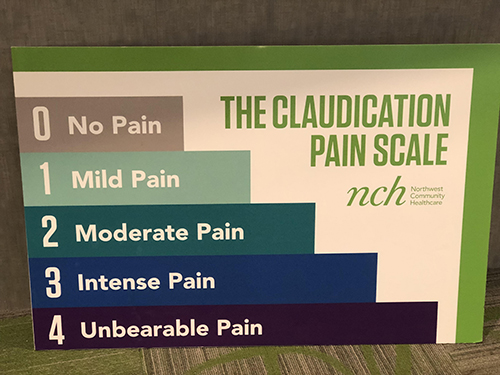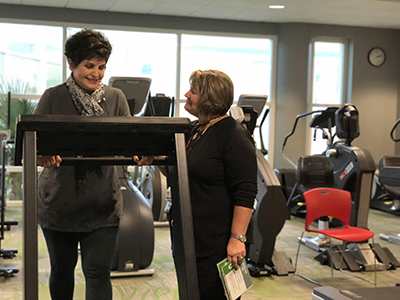Ready, SET, Go!
November 6, 2019
New program helps patients walk farther without pain
Patients who suffer from Peripheral Artery Disease (PAD) are moving – quite literally – through their pain to walk farther thanks to a new program called Supervised Exercise Therapy or SET.
What is SET?
SET starts with an assessment/evaluation followed by a structured, supervised and progressive exercise program, counseling, education and a re-evaluation/final report.
The 12-week program meets Tuesdays and Thursdays from 2 to 3 p.m. and is offered through the Cardiac Rehabilitation Department at the NCH Wellness Center on the hospital campus.
Patients walk on treadmills while medical staff monitors and guides the intensity and duration of their workouts in order to reduce their pain levels so they can better perform and enjoy daily activities.

What is PAD?
PAD affects about 8.5 million people in the U.S., but many don’t know they have it. It starts with a pain or throbbing in the legs, and many patients describe cramping or sharp pain. A primary care physician who identifies these symptoms may refer the patient to a cardiologist or vascular specialist and that pain is diagnosed as claudication, or pain caused by too little blood flow in the legs during exercise.
“Claudication is like having angina from clogged arteries in the heart, but it’s in your legs,” says NCH Exercise Physiologist Clare Spires, who oversees the program. “This program is helping patients. We’re excited about the success we’ve seen as people commit to exercise and carry their progress into their everyday lives.”
The greatest benefit is the ability to keep up with activities in everyday life, such as playing with grandkids and going for walks without having to stop due to pain.
Patient success story
Lake Barrington resident Jan Mirabella, 76, was the first to graduate from the program. She started when it launched in June 2019 and finished in August. At the start of SET, she couldn’t walk more than three minutes without experiencing extreme, debilitating pain.
“I had a handicapped placard in my car so I could park close to the stores,” Jan says. “Now I can walk 30 minutes on an incline.”

Patients start by walking at a speed that causes little or no pain and stop when they experience intense pain. Then they rest and start again. It’s a process Debbie Gianokopolous, R.N. describes as “pushing through the pain.” Debbie is part of the staff that monitors patients’ vitals during workouts.
“The key is to improve the circulation to the lower extremities by continuing to gradually and systematically increase the level of walking,” Debbie says. “That’s where their pain occurs – it’s when they walk. And as we know, we have to walk to do everything we do in life.”
The staff decides when it’s appropriate for patients to increase the intensity and longevity of their workouts.
“We coach and encourage these patients, and we don’t change their workloads until they can accomplish eight to 10 minutes without rest,” Debbie says.
At that point, the speed and or elevation of the treadmill is increased. As workloads are increased over time, physiological changes take place in the muscles and vascular system that allow the individual to walk farther and longer without symptoms.
“He called for a cab and he picked me up and carried me into it,” Jan recalls. “I came home and rested my legs.”
Jan is hopeful that more patients with PAD can discover the SET program.
“I hope all of the cardiologists, vascular specialists and physicians know about this program and refer their patients because it works,” she says. “When a program works, you want other people to benefit from it.”
If you or someone you know has symptoms of PAD and would like more information on SET, call 847-618-7910.
Arteries can slowly become narrowed or blocked by:
- Smoking
- Elevated blood pressure
- High cholesterol
- Diabetes
Common symptoms include cramps, pain or fatigue in the legs, thighs or buttocks brought on by exercise (especially walking) and relieved by rest.